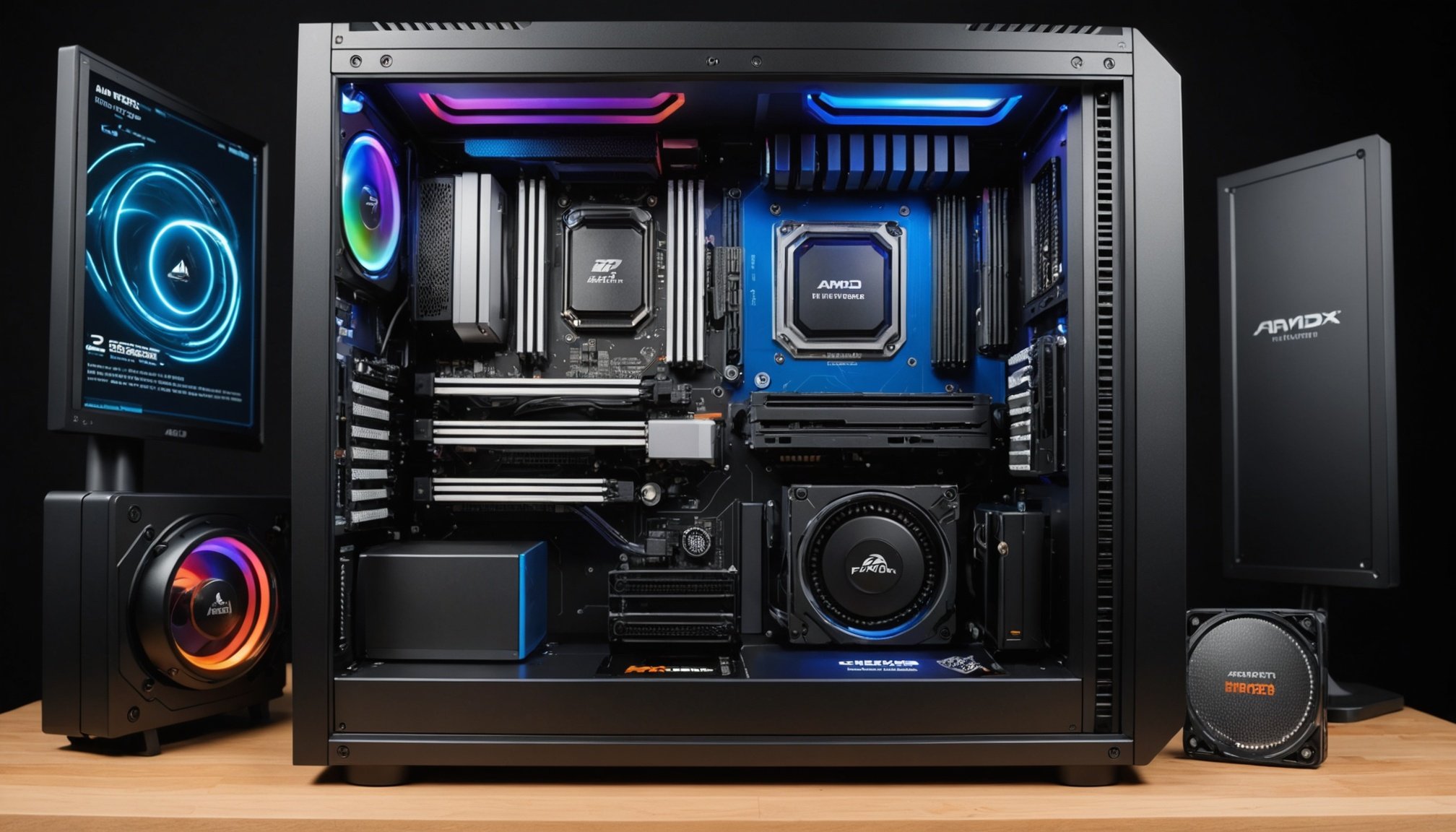Overview of AMD Threadripper 3960X
The AMD Threadripper 3960X is a powerhouse in the world of high-performance CPUs, renowned for its exceptional 3D rendering capabilities. This processor features an impressive 24 cores and 48 threads, making it a superior choice for professionals engaged in rendering tasks. Such high core count enables the processor to handle multiple processes simultaneously, significantly boosting productivity.
In addition to its core prowess, the 3960X boasts a base clock speed of 3.8 GHz, which can reach up to 4.5 GHz with turbo boost, ensuring quick and efficient processing. The Threadripper architecture also supports DDR4 memory, allowing for high-speed data access and storage. This is particularly beneficial for users requiring rapid data processing and transfer rates.
Have you seen this : Transform Your Dell PowerEdge T340: The Definitive Guide to Maximizing Data Transfer Rates with a 10GbE Network Card
When compared to other CPUs in its range, the AMD Threadripper 3960X stands out due to its capacity to manage complex rendering loads seamlessly. CPUs with fewer cores may struggle under similar workloads, often resulting in longer task completion times. The 3960X’s performance advantage makes it an attractive option for anyone seeking high-performance computing solutions.
In conclusion, the AMD Threadripper 3960X’s specifications and features make it an impeccable choice for those prioritizing 3D rendering capabilities in their computing endeavors.
This might interest you : Maximize Gaming Performance Affordably: Essential Tips to Enhance Your Dell Inspiron 5502
Essential Components for a High-Performance Workstation
Creating a high-performance workstation requires carefully selecting the essential components. With 3D rendering at the forefront of tasks, a robust GPU is crucial. Recommended options include NVIDIA’s RTX series or AMD’s Radeon Pro series, both delivering unparalleled rendering power and efficiency.
When it comes to RAM, a minimum of 32GB is advisable for seamless multitasking and handling large projects. Opt for higher frequencies, such as DDR4-3200 or DDR4-3600, to enhance processing speed further. More RAM capacity equates to better performance, particularly when running multiple software applications concurrently.
Regarding storage, consider a combination of SSD and HDD. An SSD, especially NVMe types, enhances the system’s responsiveness due to its rapid data access and boot times. For bulk storage, HDD remains cost-effective. For larger setups or data-critical tasks, RAID configurations, which offer redundancy and boosted read/write speeds, might be advantageous.
This combination of well-chosen elements ensures your workstation maintains a balance of speed, functionality, and efficiency, catering proficiently to extensive rendering workloads. Tailoring each component to your specific needs will optimize performance, providing the backbone necessary for a successful and enduring high-performance system.
Step-by-Step Build Process
Building a high-performance workstation with the powerful AMD Threadripper 3960X requires attention to detail and knowledgeable assembly.
Tools and Equipment Needed
Before starting, ensure you have the essential tools: a Phillips screwdriver, anti-static wristband, and thermal paste. A clear, organized workspace is equally vital to assembling your workstation safely and efficiently.
Assembling the Workstation
Begin with installing the Threadripper CPU. Open the socket latch, align the processor’s notches, and gently secure it into its spot. Apply a thin layer of thermal paste before mounting the CPU cooler. Next, position the motherboard into the case, securing it with screws. Insert the RAM sticks firmly into the proper slots. Install the GPU in the PCIe slot; it should click into place.
Cable Management Tips
Proper cable management is crucial for both airflow and aesthetics. Route cables through the case’s back panels, using rubber grommets and Velcro straps. By ensuring all wiring is orderly, you enhance air circulation, which helps maintain optimal temperatures during rendering.
This detailed approach ensures that your workstation build process is streamlined, helping avoid common mistakes while optimizing the system’s overall efficiency and longevity in 3D rendering tasks.
Performance Benchmarks and Testing
For those evaluating the AMD Threadripper 3960X, understanding its performance benchmarks is crucial. Rendering tests are frequently used to assess how well a CPU manages computationally intensive tasks, specifically in 3D rendering contexts. These benchmarks provide tangible insights into the capabilities of the 3960X when compared to other setups.
Benchmark Tests Overview
Many tests, such as Cinebench R20 and Blender, cater to users looking to identify where their CPUs stand in terms of rendering speed and efficiency. These tests simulate real-world rendering tasks, providing performance scores that users can reference. The 3960X excels in these scenarios, leveraging its numerous cores and threads to deliver superior results.
Comparing Results
When placed against similar CPUs, the AMD Threadripper 3960X often outpaces its counterparts in terms of frame rates and rendering times. This advantage is attributed largely to its high core count and architecture, designed explicitly for such applications.
Optimization Tips
For enhancing rendering speed and quality, users should ensure that their system’s cooling solutions are up-to-par to prevent thermal throttling. Keeping your system updated with the latest drivers and software updates also plays a significant role in maintaining optimum performance during rendering tests.
Software Configurations for 3D Rendering
Setting up your software efficiently is key to maximizing the potential of the AMD Threadripper 3960X for 3D rendering tasks.
Recommended 3D Rendering Software
Certain rendering software pairs exceptionally well with the Threadripper. Blender and Autodesk Maya are prime examples, as they utilize the CPU’s multicore architecture effectively to enhance performance. These applications excel in complex rendering tasks, taking full advantage of the 3960X’s capabilities.
Drivers and Software Updates
Keeping your drivers updated is crucial for ensuring peak performance. AMD’s official website provides regular driver updates tailored to optimize performance for rendering software. Installing these updates can significantly reduce rendering times and prevent potential crashes.
Optimal Software Settings
Configuring your software settings correctly can further optimize rendering efficiency. For instance, setting the thread priority to maximum in your rendering application allows full utilization of your CPU’s power. Adjusting the tile size in your software’s render settings can also impact speed, with smaller tiles often providing smoother results for high-core-count CPUs like the Threadripper.
Through meticulous software setup and configuration, users can harness the full power of the AMD Threadripper 3960X, ensuring smooth and swift 3D rendering operations.
Troubleshooting Common Issues
Building a high-performance system around an AMD Threadripper 3960X processor can be daunting, especially when facing unexpected performance issues. One common problem involves hardware compatibility. Ensure your components, like the motherboard and RAM, support the Threadripper’s high core count and power requirements. Check manufacturers’ compatibility lists to avoid mismatches.
Identifying Bottlenecks
Performance bottlenecks often stem from inadequate cooling or mismatched components. High temperatures can cause thermal throttling, reducing performance. Verify that your cooling solution is efficient enough for the CPU’s heat output. Monitoring software can help track temperatures and detect any anomalies early.
Solutions for Compatibility Issues
Issues related to compatibility might arise from improper BIOS settings. Check for BIOS updates that accommodate the latest Threadripper features. Ensure that your PSU can handle the energy demands of a high-performance CPU and GPU combination.
Ensuring Stability During Rendering
Stability during rendering tasks can be affected by outdated drivers. Regularly update your GPU and motherboard drivers via official sites. If crashes persist, examine overclocking settings. Sometimes, reducing overclock rates can enhance stability.
By addressing these troubleshooting steps, users can enjoy smoother operations and tackle rendering tasks without disruption, fully utilising their AMD Threadripper 3960X.
Where to Purchase Components
When assembling a high-performance workstation, finding the right buying guide is essential for acquiring the perfect parts at competitive rates. Whether you’re looking for a high-end AMD Threadripper 3960X or any other processor, certain strategies will help ensure a smooth purchasing process.
Recommended Retailers
For reliable component availability, major retailers like Amazon, Newegg, and Micro Center are renowned for their extensive range and competitive pricing on cutting-edge CPUs and other hardware. These platforms frequently offer bundle deals, which can be particularly advantageous when buying multiple items.
Finding the Best Deals
Keep an eye on tech forums and community boards for promotions. Retailers often announce discounts and warranties before major sales events. Signing up for newsletters can also yield exclusive offers.
Verify Compatibility
Before making a purchase, it’s crucial to confirm component compatibility. Be sure to cross-reference specifications with your existing or planned system setup to avoid mishaps. Manufacturer websites typically provide lists of supported hardware, assisting in making informed decisions.
When considering where to buy your components, balancing cost against reputation and reliability ensures that you’re investing in quality hardware that meets your performance expectations.
Conclusion and Future Upgrades
When considering future upgrades for your high-performance workstation, it’s vital to recognize indicators that suggest the need for enhancements. Over time, tasks may become more demanding, requiring further performance boosts. Regular rendering delays or increased cooldown periods on your system could indicate it’s time to upgrade components.
Potential Components for Upgrading
- GPU: As rendering software evolves, newer GPUs like NVIDIA’s RTX series or AMD’s RDNA series may offer better performance enhancement.
- RAM: Increasing RAM or opting for newer standards can significantly improve multitasking capabilities.
- Storage Solutions: Transitioning to advanced NVMe SSDs provides faster data access – crucial for intricate rendering projects.
Staying Updated with Technology
To maintain an enduring workstation, it’s essential to keep abreast of evolving technology trends. This may involve monitoring CPU advancements or software updates that could leverage hardware more efficiently. Regular software updates also ensure compatibility with new technologies.
Strategically planning future upgrades ensures consistent performance by preventing bottlenecks and keeping your setup in pace with industry developments. This forward-thinking approach enhances the workstation longevity, offering reliability and efficiency for your 3D rendering needs.

